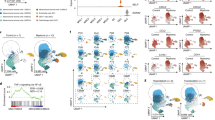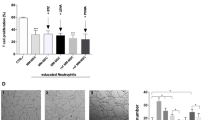Abstract
Although IL-6 has been identified as a major growth factor in multiple myeloma (MM), it is believed that maintenance of tumor growth in vivo depends on one or more additional stroma-derived factors. We describe a new human myeloma cell line (MM5.1) that can be maintained in the presence of bone marrow-derived stromal cell layers, and not only when cultured with exogeneous IL-6. This cell line expresses the same immunoglobulin κ light chain RNA sequence as the patient’s original tumor cells, has a plasma cell morphology and expresses plasma cell antigens (cytoplasmic κ light chain, CD38, BB4). Without the presence of stromal factors, MM5.1 cells become apoptotic. A low proliferative effect was observed in the presence of oncostatin M (OSM) but other cytokines (IL-10, IL-11, stem cell factor (SCF) and leukemia inhibitory factor (LIF)) had no effect at all. We observed that MM5.1 cells also grow when physically separated from stromal cell layers by a 0.45 μm microporous membrane or when cultured in conditioned medium from stromal marrow cells. Unexpectedly, the growth in stromal supernatants was markedly inhibited by an anti-IL-6 antiserum and an anti-IL-6 receptor transducer chain (gp130) mAb in a dose-dependent manner. This implies that MM5.1 cells are IL-6 responsive only when exposed to one or more additional soluble factor(s) derived from bone marrow stroma. Coculturing MM5.1 cells with IL-6 and cytokines that were described to increase the IL-6 responsiveness of myeloma cells (G-CSF, GM-CSF and IL-3) had no effect on the growth or survival. A strong proliferative effect was observed when MM5.1 cells were cultured with IL-6 and soluble IL-6 receptor (sgp80). However no sgp80 could be detected in stromal supernatants using a sensitive immunoassay. This indicates that sustained proliferation of the MM5.1 cell line depends on a combination of IL6 and at least one, thus far unidentified, stroma-derived factor. After more than 1 year in continuous culture, we could obtain a variant of the line (MM5.2) that shows an improved growth rate and grows stroma independently. Molecular analysis revealed clonal identity with the early passage form and Epstein–Barr virus antigen expression was negative. The two variants of this cell line offer a useful model to identify molecular mechanisms involved in clonal evolution towards stroma-independent growth of myeloma cells.
This is a preview of subscription content, access via your institution
Access options
Subscribe to this journal
Receive 12 print issues and online access
$259.00 per year
only $21.58 per issue
Buy this article
- Purchase on Springer Link
- Instant access to full article PDF
Prices may be subject to local taxes which are calculated during checkout
Similar content being viewed by others
Author information
Authors and Affiliations
Rights and permissions
About this article
Cite this article
Van Riet, I., De Greef, C., Aharchi, F. et al. Establishment and characterization of a human stroma-dependent myeloma cell line (MM5.1) and its stroma-independent variant (MM5.2). Leukemia 11, 284–293 (1997). https://doi.org/10.1038/sj.leu.2400564
Received:
Accepted:
Issue Date:
DOI: https://doi.org/10.1038/sj.leu.2400564
Keywords
This article is cited by
-
Endothelial cell-driven regulation of CD9 or motility-related protein-1 expression in multiple myeloma cells within the murine 5T33MM model and myeloma patients
Leukemia (2006)
-
Chemokine receptor CCR2 is expressed by human multiple myeloma cells and mediates migration to bone marrow stromal cell-produced monocyte chemotactic proteins MCP-1, -2 and -3
British Journal of Cancer (2003)
-
The promotion of plasmacytoma tumor growth by mesenchymal stroma is antagonized by basic fibroblast growth factor induced activin A
Leukemia (2001)
-
Agonist anti-gp130 transducer monoclonal antibodies are human myeloma cell survival and growth factors
Leukemia (2000)



